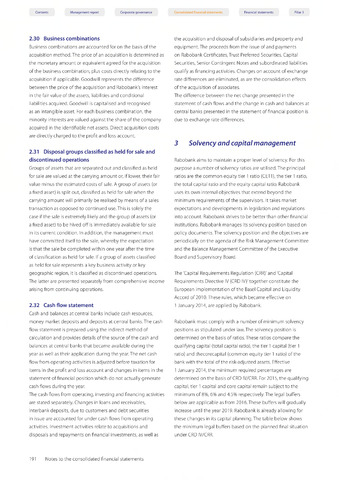3 Solvency and capital management
Contents Management report Corporate governance Consolidated financial statements Financial statements Pillar 3
2.30 Business combinations
Business combinations are accounted for on the basis of the
acquisition method. The price of an acquisition is determined as
the monetary amount or equivalent agreed for the acquisition
of the business combination, plus costs directly relating to the
acquisition if applicable. Goodwill represents the difference
between the price of the acquisition and Rabobank's interest
in the fair value of the assets, liabilities and conditional
liabilities acquired. Goodwill is capitalised and recognised
as an intangible asset. For each business combination, the
minority interests are valued against the share of the company
acquired in the identifiable net assets. Direct acquisition costs
are directly charged to the profit and loss account.
2.31 Disposal groups classified as held for sale and
discontinued operations
Groups of assets that are separated out and classified as held
for sale are valued at the carrying amount or, if lower, their fair
value minus the estimated costs of sale. A group of assets (or
a fixed asset) is split out, classified as held for sale when the
carrying amount will primarily be realised by means of a sales
transaction as opposed to continued use. This is solely the
case if the sale is extremely likely and the group of assets (or
a fixed asset) to be hived off is immediately available for sale
in its current condition. In addition, the management must
have committed itself to the sale, whereby the expectation
is that the sale be completed within one year after the time
of classification as held for sale. If a group of assets classified
as held for sale represents a key business activity or key
geographic region, it is classified as discontinued operations.
The latter are presented separately from comprehensive income
arising from continuing operations.
2.32 Cash flow statement
Cash and balances at central banks include cash resources,
money market deposits and deposits at central banks. The cash
flow statement is prepared using the indirect method of
calculation and provides details of the source of the cash and
balances at central banks that became available during the
year as well as their application during the year.The net cash
flow from operating activities is adjusted before taxation for
items in the profit and loss account and changes in items in the
statement of financial position which do not actually generate
cash flows during the year.
The cash flows from operating, investing and financing activities
are stated separately. Changes in loans and receivables,
interbank deposits, due to customers and debt securities
in issue are accounted for under cash flows from operating
activities. Investment activities relate to acquisitions and
disposals and repayments on financial investments, as well as
the acquisition and disposal of subsidiaries and property and
equipment. The proceeds from the issue of and payments
on Rabobank Certificates,Trust Preferred Securities, Capital
Securities, Senior Contingent Notes and subordinated liabilities
qualify as financing activities. Changes on account of exchange
rate differences are eliminated, as are the consolidation effects
of the acquisition of associates.
The difference between the net change presented in the
statement of cash flows and the change in cash and balances at
central banks presented in the statement of financial position is
due to exchange rate differences.
Rabobank aims to maintain a proper level of solvency. For this
purposea number of solvency ratios are utilised.The principal
ratios are the common equity tier 1 ratio (CET1), the tier 1 ratio,
the total capital ratio and the equity capital ratio. Rabobank
uses its own internal objectives that extend beyond the
minimum requirements of the supervisors. It takes market
expectations and developments in legislation and regulations
into account. Rabobank strives to be better than other financial
institutions. Rabobank manages its solvency position based on
policy documents. The solvency position and the objectives are
periodically on the agenda of the Risk Management Committee
and the Balance Management Committee of the Executive
Board and Supervisory Board.
The'Capital Requirements Regulation (CRR)'and 'Capital
Requirements Directive IV (CRD IV)'together constitute the
European implementation ofthe Basel Capital and Liquidity
Accord of 2010.These rules, which became effective on
1 January 2014, are applied by Rabobank.
Rabobank must comply with a number of minimum solvency
positions as stipulated under law.The solvency position is
determined on the basis of ratios.These ratios compare the
qualifying capital (total capital ratio), the tier 1 capital (tier 1
ratio) and thecorecapital (common equity tier 1 ratio) ofthe
bank with the total ofthe risk-adjusted assets. Effective
1 January 2014, the minimum required percentages are
determined on the basis of CRD IV/CRR. For 2015, the qualifying
capital, tier 1 capital and core capital remain subject to the
minimum of 8%, 6% and 4.5% respectively.The legal buffers
below are applicable as from 2016.These buffers will gradually
increase until the year 2019. Rabobank is already allowing for
these changes in its capital planning.The table below shows
the minimum legal buffers based on the planned final situation
under CRD IV/CRR.
191 Notes to the consolidated financial statements

